14 Jade Plant Varieties and How to Care for Them
Jade plants are popular for their thick leaves, easy care, and charming appearance. They come in many shapes, sizes, and colors, making them fun to grow and collect. Some have rounded leaves, while others have twisted or stacked ones. A few even change color when placed in sunlight. These plants grow slowly and can live for many years with the right care. They do not need much water, and they enjoy bright spots in your home. Knowing the different types and how to care for them can help you keep them healthy and looking their best.
This post may contain affiliate links, which helps keep this content free. Please read our disclosure for more info.
Crassula Ovata (Common Jade Plant)
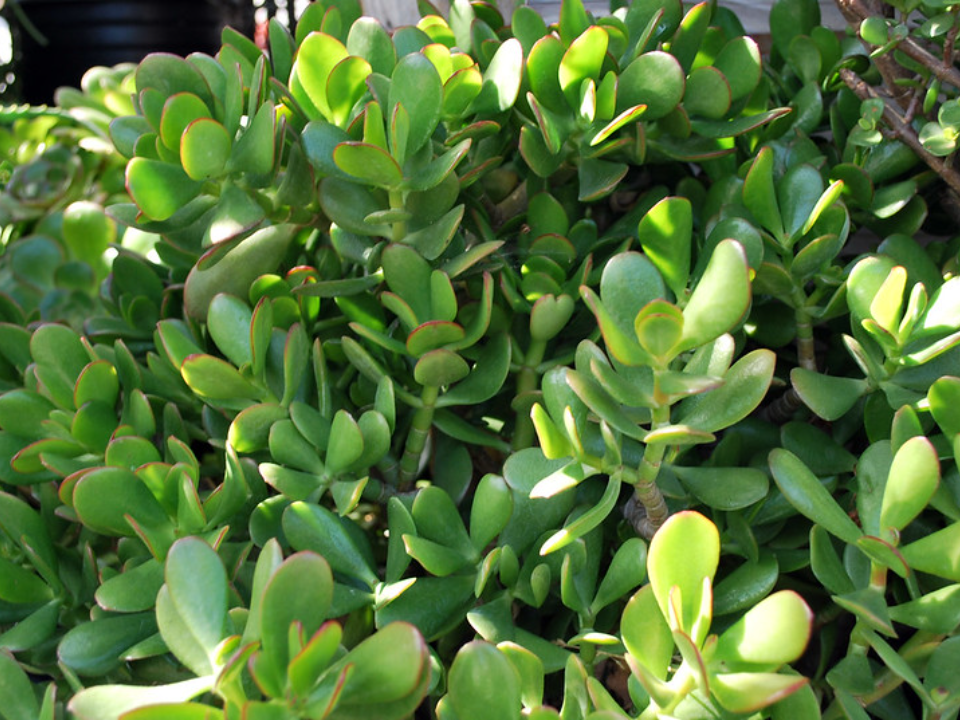
The Crassula Ovata is the most familiar jade plant and often the one people first think of when they hear the name. Its thick, oval-shaped green leaves have a smooth, waxy surface that reflects light beautifully. In full sun, the edges of the leaves often turn reddish, adding extra visual interest. As it matures, the stems thicken and become woody, giving it the appearance of a miniature tree. Some people even shape it into bonsai form with careful pruning over the years. It can live for decades and grow to about three feet tall indoors, making it a long-lasting and rewarding choice. It is commonly found in homes, offices, and plant shops for a reason.
To care for this jade plant, place it in a sunny area with at least four hours of direct light daily. South or west-facing windows usually work best. Use a well-draining soil mix, such as cactus or succulent soil, to avoid soggy roots. Water only when the top inch or two of the soil feels dry. During winter months, water less frequently since the plant enters a resting period. Avoid fertilizing too often, as this can encourage leggy growth. A light feeding once in spring is usually enough. With minimal care, it will thrive and become a lasting part of your plant collection.
Crassula Ovata ‘Gollum’

Crassula Ovata ‘Gollum’ stands out due to its peculiar leaf shape. Instead of flat leaves, it has tubular, finger-like leaves with curled tips that resemble the ears of a certain fantasy character. The tips may become tinged with red if the plant receives enough sunlight. This quirky appearance makes it a fun choice for collectors or anyone looking to add a more unusual plant to their space. Like most jade plants, it grows slowly but becomes more interesting with time. It tends to stay compact, making it great for small containers. As it matures, it may produce small star-shaped white flowers in cooler months.
Place this plant near a bright window where it can get a mix of direct and indirect light. Too little light may cause it to lose its unique coloring and shape. Allow the soil to dry completely between watering, and always use containers with drainage holes. If kept in a pot that holds too much water, the roots may start to rot. Pruning is rarely needed, but you can remove any branches that look unhealthy or unbalanced. Repot only when it becomes rootbound, usually every few years. With its odd shape and easy care, it adds personality to any plant shelf or desk.
Crassula Ovata ‘Hobbit’
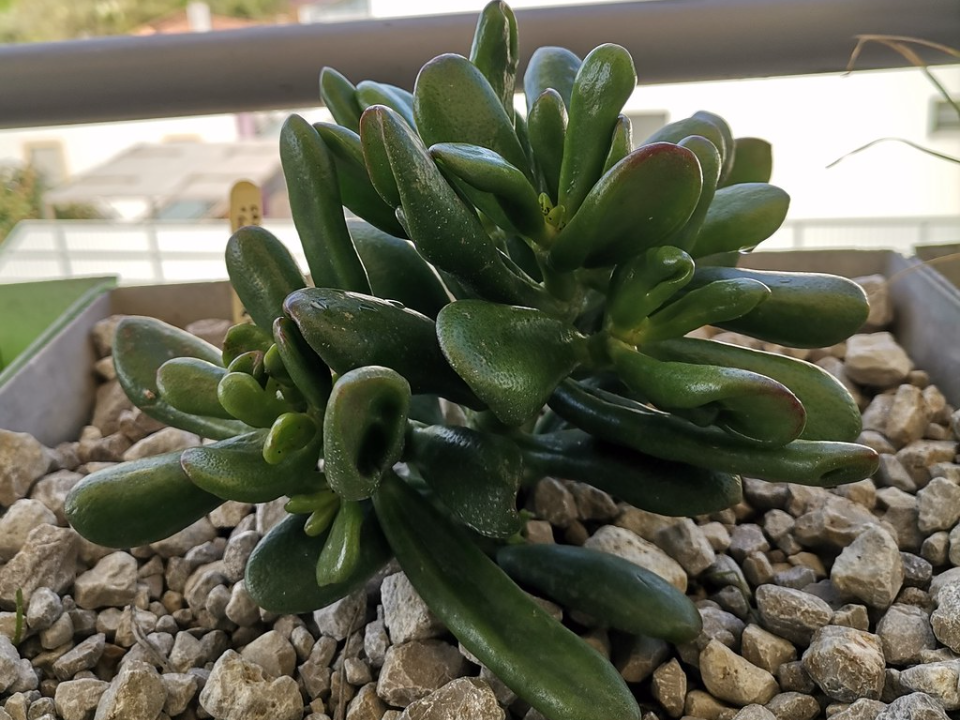
The ‘Hobbit’ variety is often confused with ‘Gollum’ because they both have unusual tubular leaves. However, the leaves on ‘Hobbit’ are shorter, slightly curled inward, and appear more compact. The overall look is just as quirky but with a softer feel. Like its relatives, it develops thick woody stems and becomes more tree-like over time. This plant works well in small pots or as part of a mixed succulent arrangement. Its slow growth and playful shape make it a favorite for windowsills, workspaces, and even fairy garden setups. With enough light, it may bloom in late winter, producing small white or pinkish flowers.
To care for ‘Hobbit’, place it where it can receive at least a few hours of bright light daily. It will tolerate lower light, but the leaf color and compact shape will show better with more exposure. Use a well-draining mix and avoid letting the plant sit in water. Allow the soil to dry thoroughly before watering again. Fertilize lightly during the growing season with a diluted liquid fertilizer. If it grows unevenly, turn the pot every couple of weeks to help it grow straight. This variety is low effort and ideal for those who want something different without extra maintenance.
Crassula Arborescens (Silver Jade)
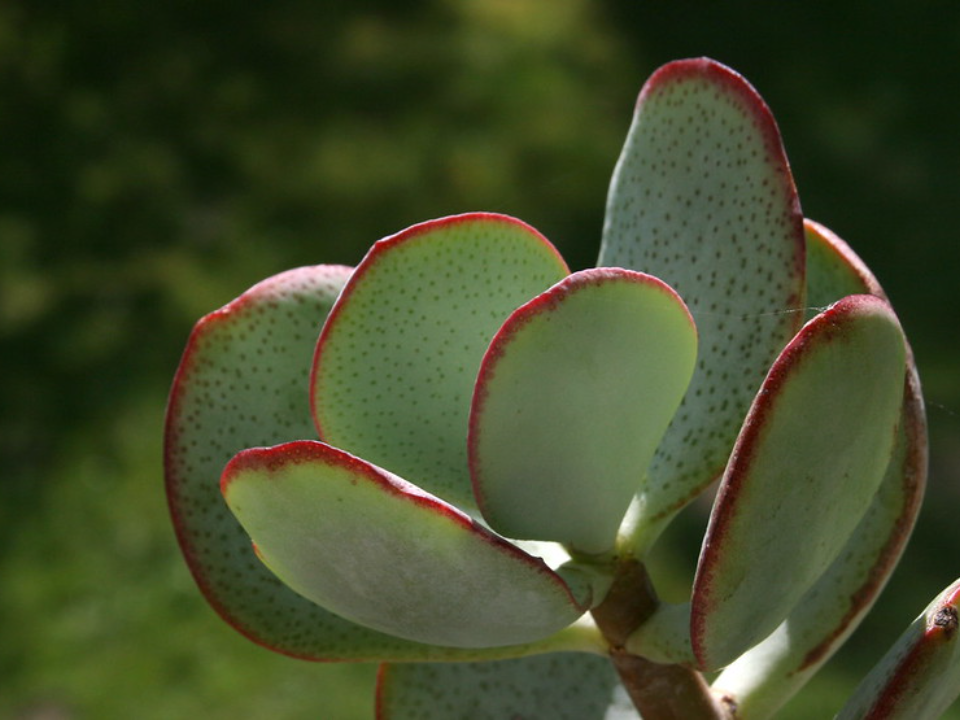
Often referred to as the Silver Dollar Plant, Crassula Arborescens offers a different look compared to the standard jade. Its round, flat leaves have a soft silver-blue hue with red margins, and a powdery surface that gives them a frosted look. This unique coloring sets it apart and adds a subtle contrast in succulent displays. As the plant grows, the stems become thick and woody, creating a strong base that can support its broad leaf clusters. It can reach two to four feet tall indoors if given enough space and care. In the right conditions, it will also produce tiny pink or white flowers during the colder months.
This plant prefers full sun, so place it near a bright window or in an outdoor space that receives several hours of light. Use well-draining soil and only water when the soil is completely dry. During the colder seasons, reduce watering even more. Overwatering is the most common mistake and can lead to root rot or soft, discolored leaves. Occasional pruning helps maintain its shape and encourages denser growth. Choose a heavier pot to keep it stable, as it can become top-heavy over time. The Silver Jade brings a calm, elegant feel to any plant collection while remaining just as easy to care for.
Crassula Ovata ‘Tricolor’
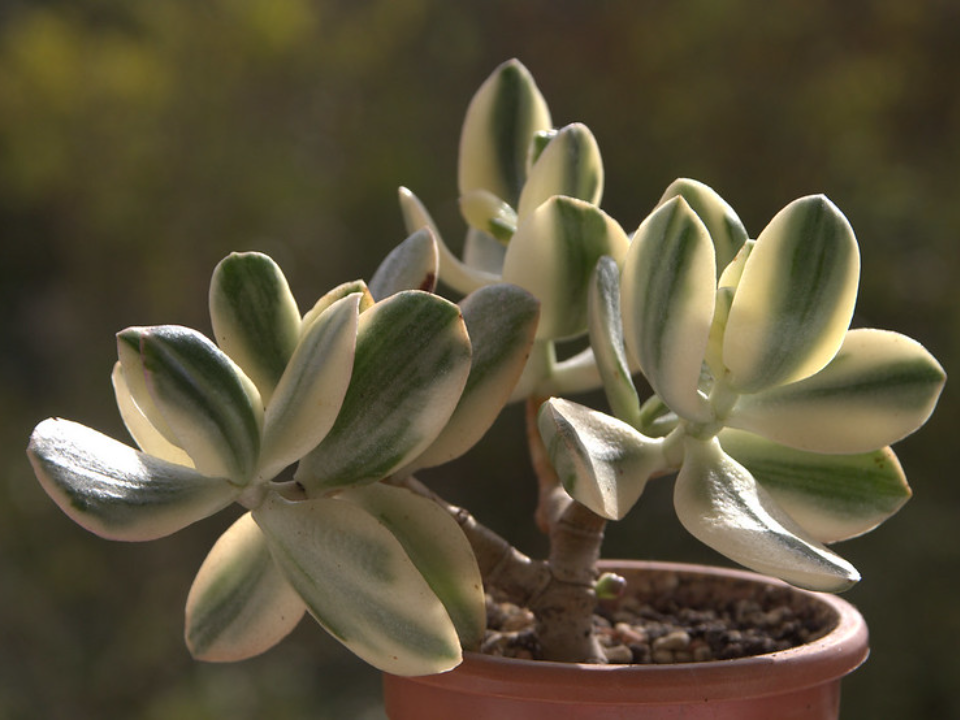
This jade plant adds a splash of color with its cream, green, and pink-striped leaves. The variegation gives the plant a more cheerful look compared to plain green types. When placed in strong light, the pink tones become more noticeable, especially at the leaf edges. This makes it a lovely choice for those who enjoy plants with soft color shifts throughout the year. The plant grows slowly and remains compact, which works well for windowsills or small containers. Like others in the Crassula family, it may bloom in winter with small, star-shaped white flowers. Its gentle color and tidy growth habit make it a popular houseplant.
Place ‘Tricolor’ in a bright location with a few hours of direct sunlight each day. Avoid placing it in dark areas, as low light can cause the plant to lose its pink color and become more green. Water only when the top inch of soil is dry and reduce watering during colder months. A clay or ceramic pot can help wick away extra moisture from the roots. Fertilize only once or twice during spring and summer with a diluted succulent fertilizer. Trim away any leggy growth if the plant starts to stretch toward the light. With the right care, it stays healthy and colorful without much effort.
Crassula Ovata ‘Lemon and Lime’
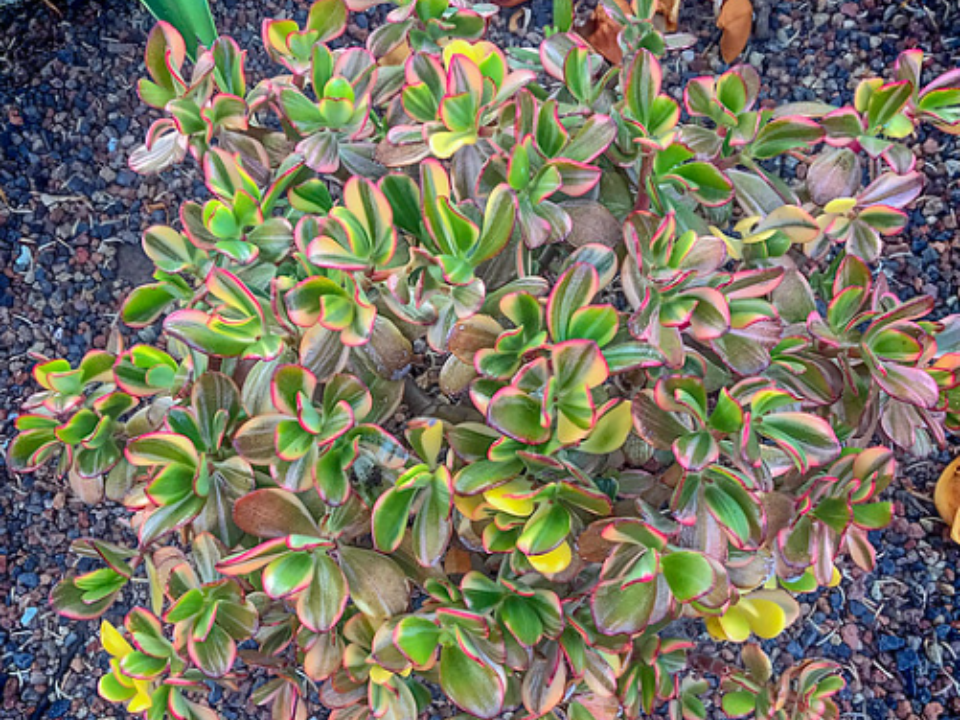
Crassula Ovata ‘Lemon and Lime’ stands out because of its green leaves that are striped with shades of yellow and cream. When exposed to strong sunlight, the edges of the leaves may develop a soft red tint, adding even more interest. The overall shape of the plant remains similar to the common jade, with thick stems and a bushy form. This version grows slowly and remains compact, making it a good fit for small pots, desktops, or bright kitchen windows. Over time, the branches can become woody, helping the plant stand upright without needing support. If cared for properly, it can bloom with small white flowers in late fall or winter. The bright foliage gives any plant setup a lively pop of color.
To help ‘Lemon and Lime’ keep its beautiful colors, place it where it will receive bright indirect light or morning sun. If the plant receives too little light, the yellow and cream bands may fade, and the leaves may turn more green overall. Water the plant only when the soil is completely dry and avoid letting water sit in the saucer. Use a gritty succulent mix and a container with drainage holes to keep the roots healthy. During winter, reduce watering to prevent rot. Fertilize lightly in spring if the plant looks like it needs a boost. With simple care, this variety stays colorful and eye-catching year-round.
Crassula Tetragona (Miniature Pine Tree)
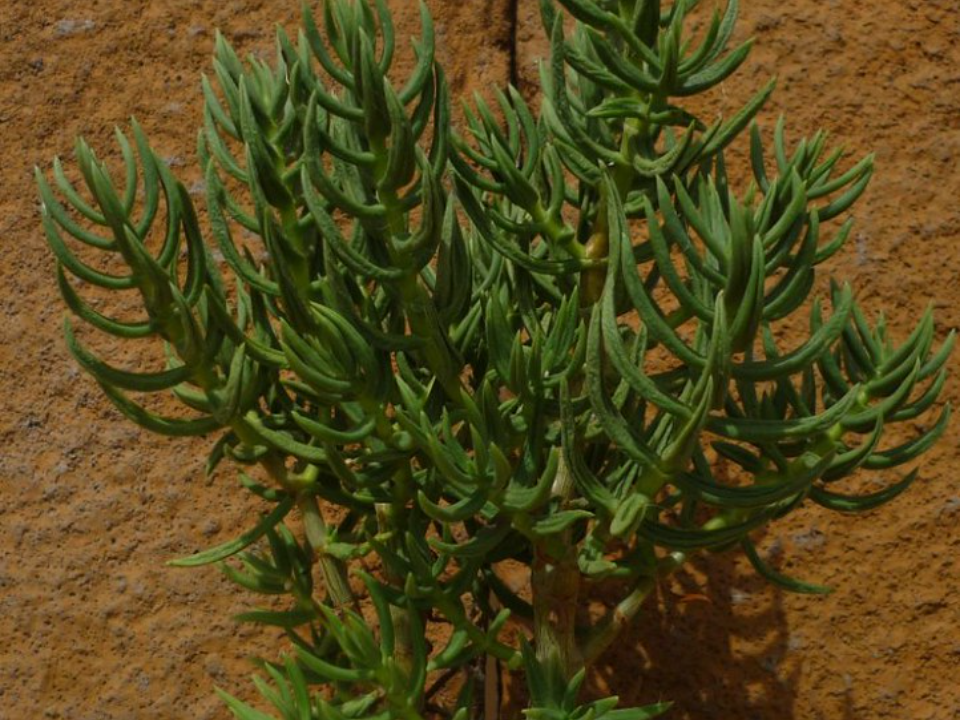
Crassula Tetragona is often called the Miniature Pine Tree because of its tall, upright stems and narrow, pointed leaves. Unlike other jade plants, its foliage resembles pine needles, which gives it a very different look from the usual thick, rounded leaves. This variety tends to grow more quickly and can reach up to three feet tall if given space and good lighting. The stems become woody at the base, giving the plant a more tree-like appearance as it matures. It works well in outdoor planters, raised beds, or even as a background plant in succulent arrangements. During its growing season, you might see small white flowers appear at the top of the stems. It brings a different texture to succulent collections and looks especially nice in taller containers.
To care for Crassula Tetragona, give it plenty of light each day. Full sun will help it grow upright and keep its leaves compact, while low light may cause the stems to stretch and bend. Water the plant only after the soil has dried completely, and always make sure your pot drains well. This variety is a good fit for warm outdoor areas but must be brought inside before temperatures drop. Use a cactus soil mix or add sand to regular potting soil for better drainage. Prune the tips if you want to encourage bushier growth, or let it grow tall for a more natural look. It is an easy plant to manage as long as it gets enough light and stays dry between watering.
Crassula Perforata (String of Buttons)
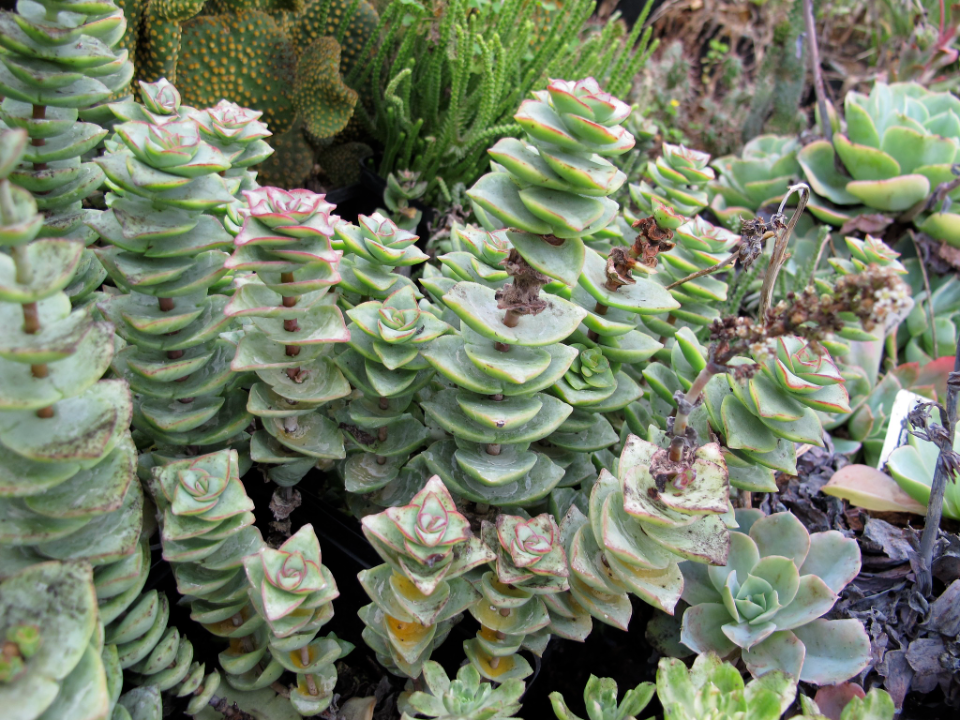
Crassula Perforata is a trailing succulent that grows in stacked layers of triangular leaves along a stem. The leaves are usually pale green or bluish with pinkish edges, especially when exposed to bright sunlight. The plant grows in a slightly twisted spiral pattern, which gives it a playful and almost whimsical appearance. It is often used in hanging baskets or shallow dish gardens, where it can trail over the edges and add height and texture. When it blooms, you may notice small clusters of flowers that appear along the upper parts of the stems. This plant is a favorite among collectors for its unique look and low-maintenance care. It stays compact but spreads well if given space.
Place this plant in a spot that gets bright but indirect light. While it can handle some morning sun, too much intense sunlight may cause the edges to burn. Water sparingly, letting the soil dry out completely before the next watering. It is sensitive to overwatering, so a gritty, fast-draining soil mix is important. If the plant becomes too leggy or long, you can trim the stems and replant the cuttings. Repotting every few years helps refresh the soil and gives the roots room to grow. With proper light and a dry routine, String of Buttons will continue to thrive and trail beautifully.
Crassula Rupestris (Baby’s Necklace)
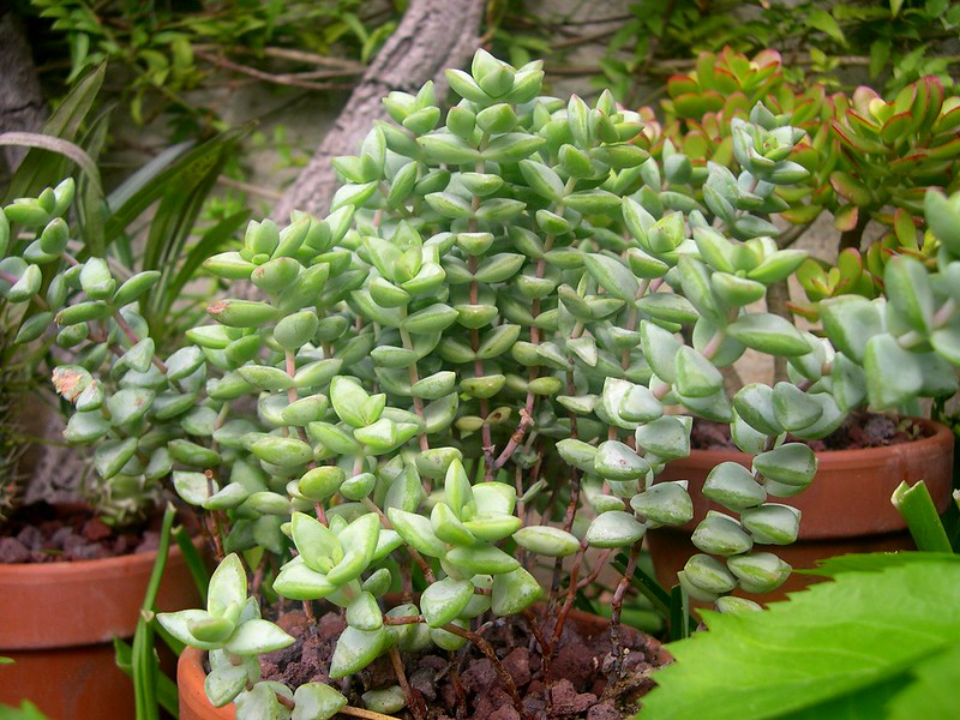
Crassula Rupestris, often called Baby’s Necklace, forms tight clusters of leaves that stack along thin stems. The leaves are rounded, plump, and have soft red or pink edges when grown in sunlight. The plant resembles a string of tiny beads, which is where its nickname comes from. As it grows, it develops a sprawling shape that works well in shallow containers or hanging planters. It can also be used as a filler plant in mixed succulent pots because of its colorful and compact growth. During spring, it produces tiny flowers that add a delicate touch to its appearance. Its small size and interesting form make it a lovely addition to any collection.
To grow Baby’s Necklace successfully, place it where it will get at least a few hours of bright light daily. The more sun it receives, the more colorful the edges will become. Water the plant only when the soil feels dry to the touch. Use a succulent-friendly soil and a pot that drains well to avoid soggy roots. This plant is easy to propagate by cutting the stems and planting them in new soil. Remove any dead leaves from the base to keep it tidy. With a little light and dry conditions, it keeps its necklace-like form and remains healthy throughout the year.
Crassula Ovata ‘Monstruosa’
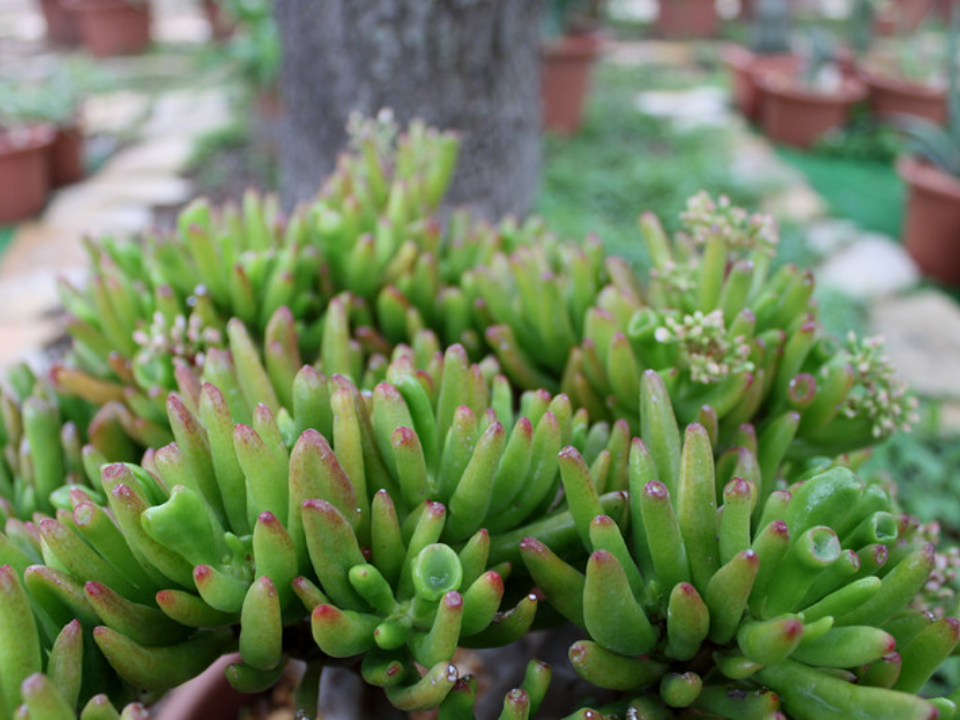
Crassula Ovata ‘Monstruosa’ is a unique and unusual jade variety that produces twisted and curled leaves. Some leaves appear as tubes, while others are wavy or folded in odd shapes. This gives the plant a wild, sculptural appearance that stands out in any plant group. It can grow into a small shrub with multiple branches and a woody base over time. The odd shapes are more pronounced when the plant receives strong sunlight. It often draws attention and becomes a conversation piece due to its strange appearance. Like other jade plants, it may also flower in cooler seasons when conditions are right.
To grow this plant successfully, give it a location with bright sunlight. The odd leaf shapes become more defined and colorful with good light exposure. Avoid watering frequently and let the soil dry out before watering again. Use a well-draining potting mix and avoid letting water collect at the bottom of the pot. If it grows unevenly, rotate it every few weeks to help it grow more evenly. Prune back long or awkward stems if you want to shape it more neatly. Crassula Ovata ‘Monstruosa’ thrives under simple care and brings a bold look to any indoor garden.
Crassula Sarcocaulis
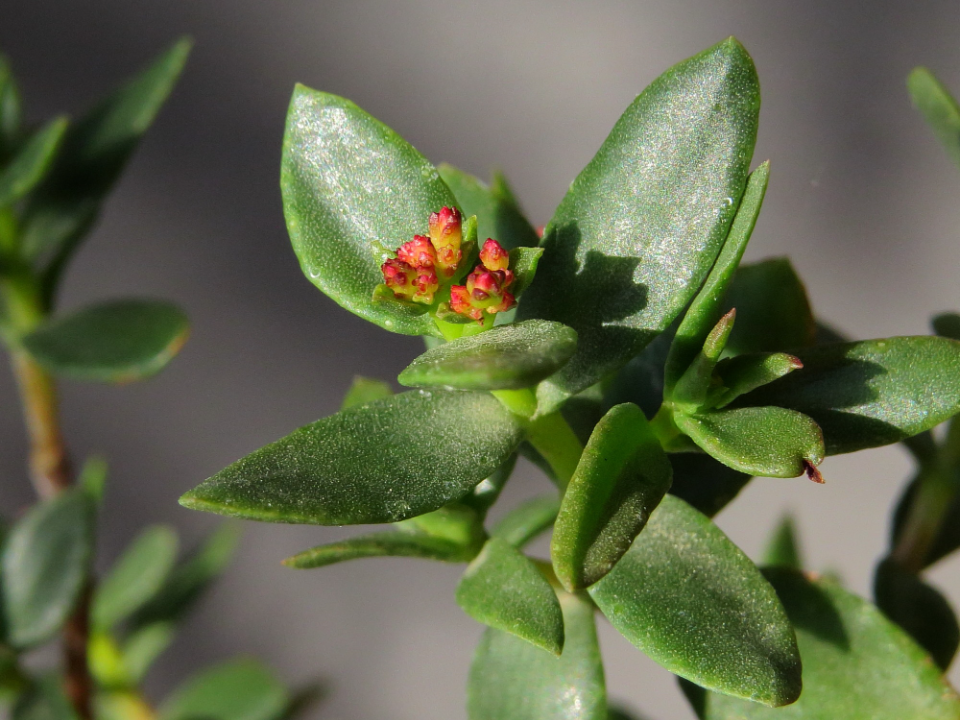
Crassula Sarcocaulis has a woody, shrub-like appearance that makes it look more like a miniature tree than a succulent. Its small green leaves are narrow and pointed, and they sometimes turn reddish when grown in strong sunlight. As it grows, the base thickens and becomes more tree-like, giving it a natural bonsai look without needing much shaping. This variety is native to higher elevations and is more tolerant of cooler temperatures than most other jade types. It can reach around two feet tall and spreads out into a well-balanced shape with age. Tiny pink flowers may appear in summer, bringing a soft pop of color. It works well in outdoor pots and does equally well indoors if placed near a bright window.
Give this plant full sunlight to encourage dense, upright growth and colorful leaves. It prefers soil that dries quickly, so use a mix made for cacti or succulents. Water only when the soil is dry, and avoid leaving it damp for long periods. This plant can handle cooler nights, but it should be protected from frost. Repotting is only needed every few years when it outgrows its pot. If branches become too long or heavy, prune lightly to maintain a tidy shape. Its woody structure and minimal care make it a solid choice for those who want something different yet dependable.
Crassula Marnieriana (Jade Necklace)
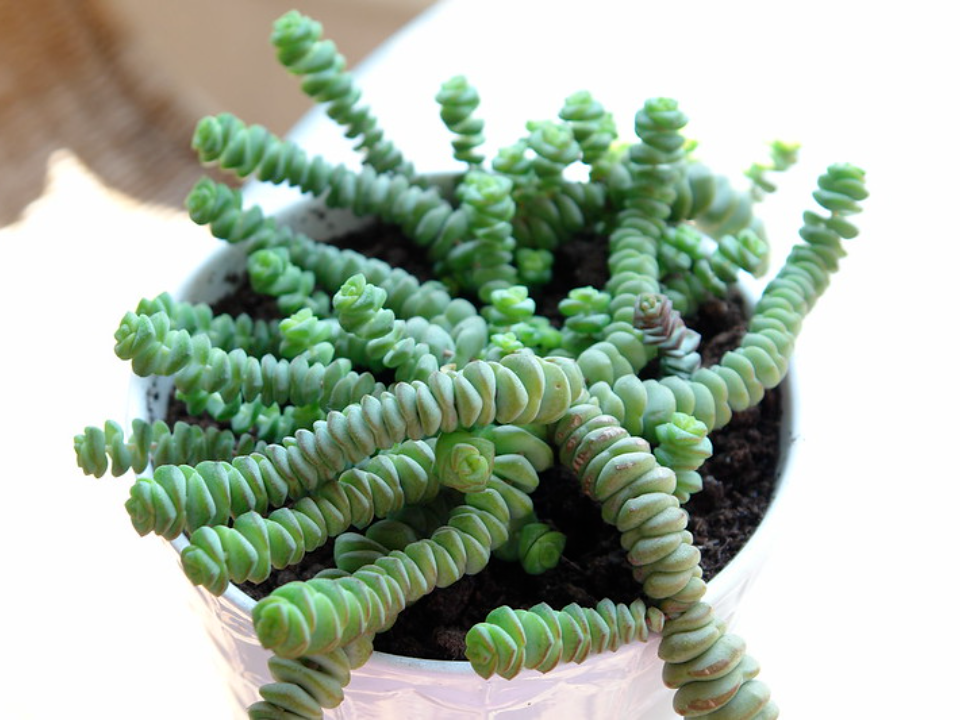
Crassula Marnieriana, often called the Jade Necklace, features short, rounded leaves tightly stacked along fleshy stems. The leaves are blue-green with edges that turn red or pink when exposed to sunlight. The overall shape looks like a string of beads or coins, which is where the nickname comes from. It grows slowly and stays compact, making it ideal for small planters or as a trailing plant in shallow containers. When grown well, it can spill gently over the sides of its pot. In the cooler months, you might see small pink flowers appear near the top of the stems. This plant brings both structure and color to succulent arrangements.
Place it in bright but indirect light to help maintain its shape and color. It will grow in lower light, but the stems may stretch and lose their tight form. Water sparingly, letting the soil dry between watering to prevent root rot. Use a container with proper drainage and gritty soil to keep the roots healthy. Prune back any long or leggy stems to encourage new, tighter growth. You can also use cuttings to start new plants if desired. With consistent care, Jade Necklace remains tidy and attractive throughout the year.
Crassula Tom Thumb
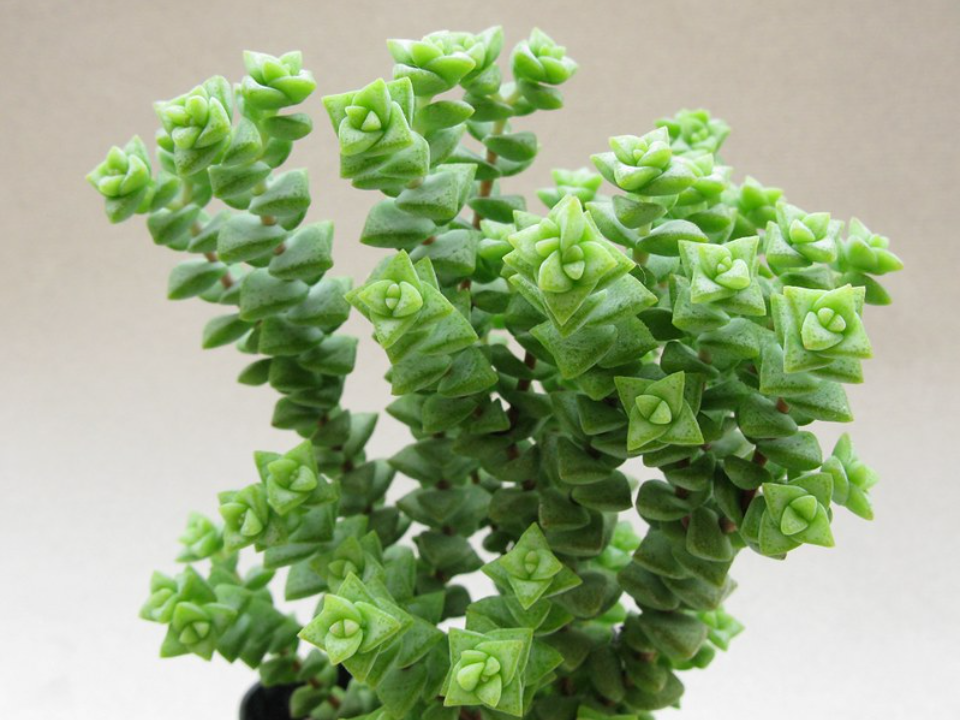
Crassula Tom Thumb is a miniature variety with a compact and tidy growth habit. It has tiny, triangular leaves that are stacked tightly in a spiral around slender stems. The leaves are green with red or burgundy edges, especially when grown in sunlight. This variety grows low and tends to spread out more than upward, making it great for borders, small pots, or ground cover in dish gardens. Its tiny size makes it perfect for those with limited space or for creating miniature garden displays. Although it grows slowly, it remains neat and rarely needs trimming. When in bloom, it may produce small white or pink flowers at the top of the stems.
To care for Crassula Tom Thumb, place it in a sunny spot with several hours of light each day. If it starts to stretch or lose its red edging, it probably needs more light. Let the soil dry out fully before watering again, and avoid water sitting at the base of the plant. Use a gritty, well-draining potting mix to help prevent root issues. If the plant becomes too long or floppy, trim the stems and replant the cuttings. It responds well to pruning and fills in nicely with time. With basic care, this small plant stays healthy and colorful without taking up much room.
Crassula Ovata ‘Hummel’s Sunset’
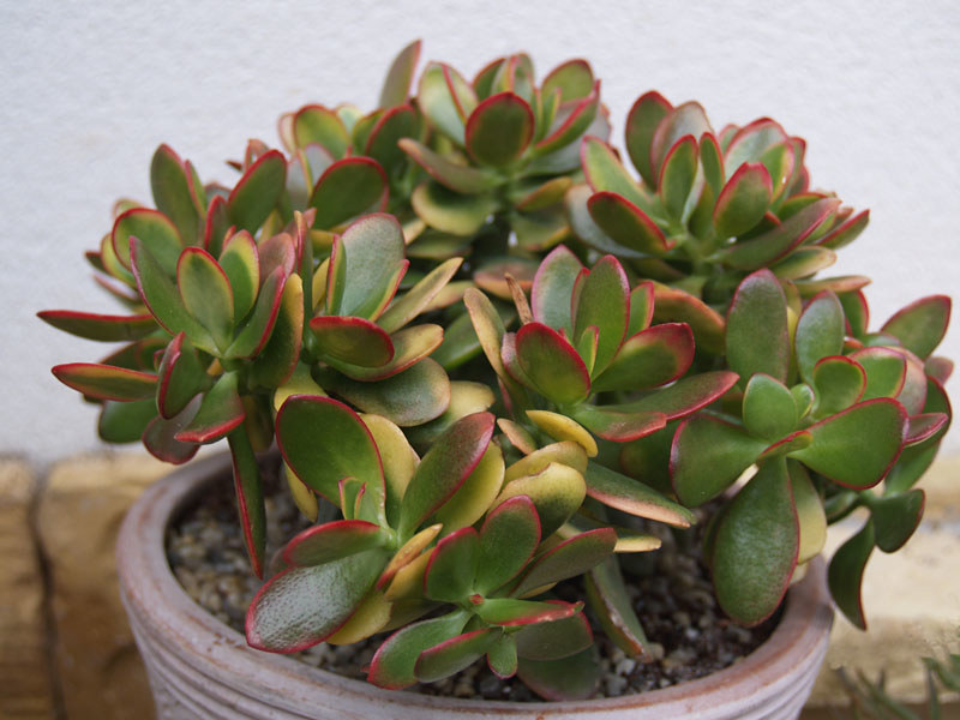
Crassula Ovata ‘Hummel’s Sunset’ is named for the golden-yellow and red colors that appear on its leaves, especially during cooler months. It has the same thick, fleshy leaves and woody stems as the common jade but with much more color. The leaves are edged in bright red, and the yellow tones become more noticeable when the plant receives plenty of sunlight. Over time, the plant grows into a compact, tree-like shape and develops a sturdy trunk. This variety can be grown in containers, rock gardens, or even as a bonsai. It is a favorite among collectors for its bright foliage and easy care. In late fall or early winter, it may bloom with clusters of small white or pale pink flowers.
Give ‘Hummel’s Sunset’ bright light to bring out the full range of colors in the leaves. Morning or afternoon sun is ideal, but protect it from harsh midday heat. Use soil that drains quickly, and water only when the soil feels completely dry. A clay pot can help keep moisture levels under control. Fertilize lightly once or twice during the growing season to support healthy growth. If the plant becomes leggy, trim it back to encourage a fuller shape. With time, this colorful jade plant becomes a standout piece in any home or garden space.
This article originally appeared on Avocadu.
